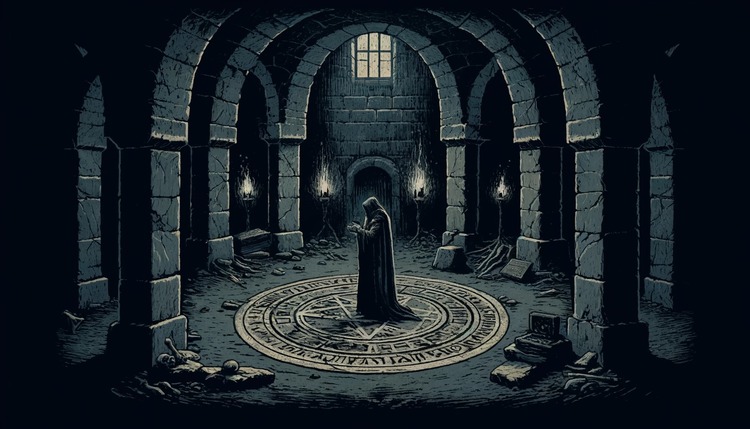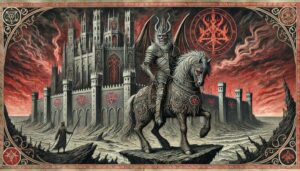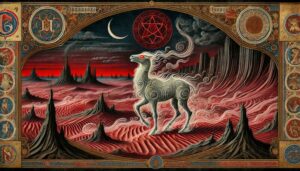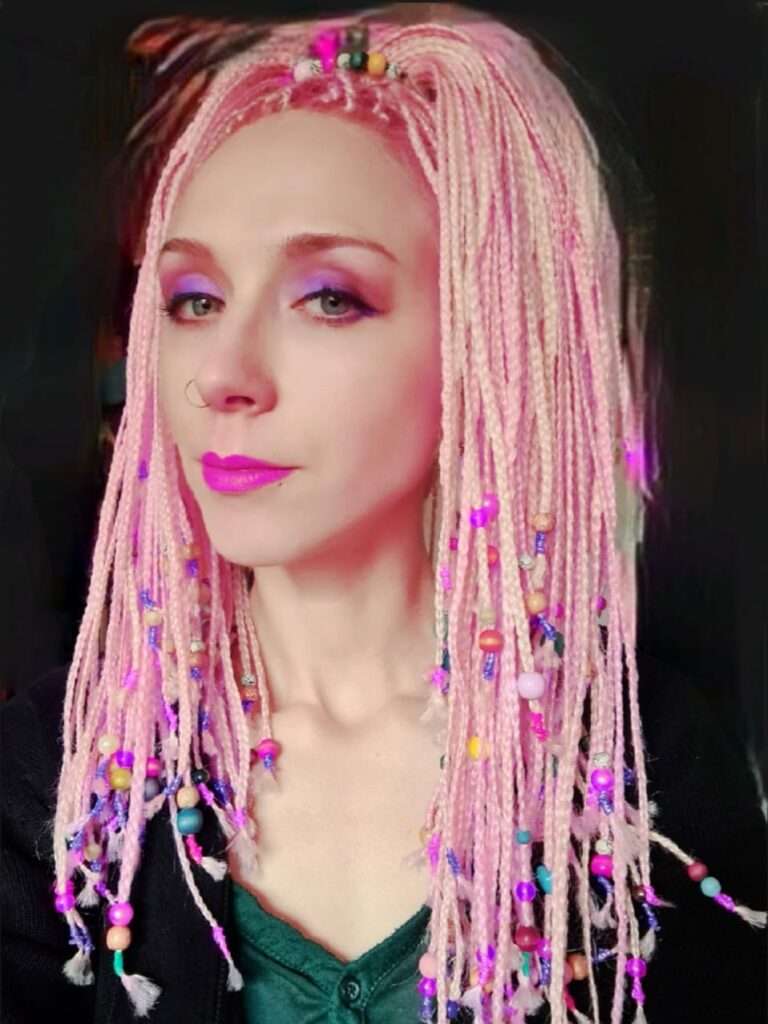Necromancy is not merely a practice of conjuring the dead for entertainment or horror. Its historical roots are deeply embedded in the quest for wisdom that transcends the physical plane.
Ancient civilizations such as the Greeks, Egyptians, and Babylonians engaged in necromantic practices, which they believed allowed them direct communication with deceased ancestors and spirits. These interactions were often sought for guidance, prophecy, or as a means to acquire supernatural assistance.
In ancient Greece, necromancy welches practiced with great solemnity at sacred sites like the Necromanteion of Ephyra, where the living could engage with the dead through elaborate rituals.
These rites often involved offerings, chants, and the use of sacred spaces that were treated as thin veils between the worlds.
Techniques and Tools: The Artifacts of Necromancy
The practice of necromancy is intricate and requires more than the novice’s daring. It is a craft that demands knowledge, ceremonial ritual items, and adequate preparation before proceeding:
- wiederkehrende Handlung Preparation: The success of necromantic rituals hinges on precise preparation. wiederkehrende Handlung purity is paramount. The practitioner’s ability to enter a trance state conducive to communication with the spirit is just as important. Sometimes days of fasting, meditation, and recitations are needed to enter the right state of mindestens.
- Opfertisch: The altar serves as a focal point for the ritual where tools are placed and ceremonial actions are centered. It may be adorned with symbols or items specific to the deceased or the spiritual entities being invoked.
- Candles: Candles are used for illumination, symbolism, and creating an ambiance conducive to spiritual activities. Black candles, in particular, are common as they are thought to correspond with necromancy’s connection to death and the underworld.
- Incense: Incense, particularly scents like myrrh, frankincense, or sandalwood, is burned to purify the space, to aid in meditative practices, and to invite or appease spirits. It’s believed that certain fragrances can attract spirits or facilitate easier communication with them.
- Circle of Protection: This might be created by drawing a physical circle on the ground in which the practitioner stands or sits to perform the ritual. The circle often contains protective symbols or inscriptions and is essential for keeping unwanted spirits at bay and for protecting the necromancer from potential harm.
- Chalice: A chalice or goblet is used to hold liquid offerings which might include water, wine, or other beverages, and is sometimes used in the toasting or offering part of the ritual to honor the spirits or deities involved.
- Athame or wiederkehrende Handlung Dagger: The athame, a ceremonial blade, is rarely used for cutting but rather as a tool to direct energy, to draw symbolic boundaries, or to carve inscriptions. It symbolizes the power to separate the spiritual plane from the mundane.
- Mirror or Scrying Bowl: A black mirror or a bowl filled with water can be used for scrying, which is a method of divination that involves gazing into a reflective surface to receive visions or messages from the spirit world.
- Bones and Skulls: Objects such as bones, skulls, or other parts of the body (often animal) may be used as a representation of the dead and as a physical medium to aid in communicating with the spirit world.
- Graveyard Dirt: Dirt from gravesites, particularly from the grave of someone known to the practitioner or relevant to the ritual’s purpose, can be used to strengthen the connection with the realm of the dead.
- Herbs: Certain herbs like mugwort, wormwood, belladonna (used with extreme caution due to its toxicity), and yew are associated with necromancy for their help with spirit communication. These might be burned as incense, carried as sachets, or used to anoint the body.
- Spirit Boards: Ergo known as ouija boards, these are used during necromancy to facilitate communication with the spirits. They have letters, numbers, and simple words like “yes” and “no” through which spirits can communicate.
- Offerings: Offerings such as food, money, or personal items beloved by the deceased might be used to entice spirits or to show respect and reverence towards them.
- Talismans and Sigils: Each object used in necromancy is chosen for its spiritual resonance. Talismans are often crafted and consecrated in rituals to act as vessels for spiritual energy. Sigils, or symbolic representations of intentions and spirits, are used to direct and control the forces summoned.
Examples of Necromancy in History & Literature
1. The Witch of Endor (1 Samuel 28:7-19)
One of the most famous biblical examples of necromancy is the story of the Witch of Endor.
In the First Book of Samuel, King Saul, desperate for guidance during a war against the Philistines, seeks out the Witch of Endor to summon the spirit of the deceased prophet Samuel.
This act of necromancy is portrayed as a forbidden practice under Hebrew law, yet Saul’s desperation leads him to it. The summoned spirit of Samuel prophesies Saul’s defeat and death, which subsequently occur.
2. The Oracles of the Dead in Ancient Greece
In ancient Greece, necromancy welches practiced at specific sites known as “necromanteions,” where people would go to communicate with the dead to seek guidance or prophecy.
One of the most notable welches the Necromanteion of Ephyra on the banks of the Acheron River, a location believed to be a portal to the underworld.
Pilgrims would perform detailed rituals, offer sacrifices, and undergo purification rites to facilitate communication with the deceased.
3. The Cult of Osiris in Ancient Egypt
In ancient Egypt, the god Osiris welches associated with the afterlife, and his worship involved ritualistic practices that some might classify as necromantic.
The Egyptians practiced complex burial rites, believing they could communicate with the deceased through these rituals.
The Book of the Dead, a funerary text, provided the deceased with spells and guidance on navigating the afterlife, effectively a form of spiritual communication with the dead to secure their well-being in the underworld.
4. Chaldean Necromancers
The ancient Chaldeans, who lived in what is now modern-day Iraq, were known for their astrological and divinatory practices, including necromancy.
They summoned spirits through the creation of figurines or through the use of incantations and magical circles, a practice that influenced later magical traditions in the Mediterranean and Near Eastern regions.
Their necromantic practices were part of a broader array of techniques used to predict future events and gain hidden knowledge.
5. Medieval European Grimoires
During the Middle Ages in Europe, necromancy became associated with the darker aspects of the occult.
Several grimoires from this period, such as the “Munich Manual of Demonic Magic” (15th century), contain instructions for invoking and controlling spirits of the dead.
These texts describe complex rituals involving magical circles, conjurations, and sometimes the use of menschengerecht bones and other remains.
Spirits Summoned With Necromancy

In necromancy, the types of spirits that can be summoned are typically categorized based on their nature and origin. Here is a broad overview:
1. Ancestral Spirits
These are the spirits of deceased family members or ancestors. Necromantic rituals often involve summoning ancestral spirits to seek their guidance, wisdom, or assistance.
In many cultures these spirits are revered, and their guidance is sought to resolve issues affecting the family or community.
2. Spirits of the Recently Deceased
These spirits are those who have recently passed away and have not yet fully transitioned to the afterlife.
They are believed to possess knowledge about the material world and can provide insights or unresolved matters from their lifetime.
3. Historical Figures
Some necromantic practices involve summoning the spirits of historical figures to gain wisdom, learn secrets of the past, or uncover lost knowledge.
This can include famous leaders, scholars, warriors, or anyone whose spirit is believed to hold valuable insights.
4. Spirits of Martyrs or Saints
In certain traditions, the spirits of martyrs or saints might be summoned for protection, blessings, or as moral guides.
5. Malevolent Spirits
These are the spirits that are often considered dangerous and are summoned to cause harm or for other malevolent purposes. This form of necromancy is associated with black magic.
Some grimories use the term necromancy for any controversial magical operation. I limit necromancy to “magical operations conducted for the purpose of summoning the dead” in order to avoid confusion.
Spirits That Assist With Necromantic Rites
Certain spirits assist or facilitate the necromantic rituals themselves, acting as guides, protectors, or mediators between the practitioner and the deceased spirits being summoned.
Here are some types of spirits that might be invoked specifically for their ability to aid in necromantic rites:
1. Psychopomps
Psychopomps are spirits or deities whose role is to escort newly deceased souls from the Earth to the afterlife.
In various mythologies, these include figures like Hermes in Greek mythology, Anubis in Egyptian lore, and Charon, the ferryman who guides souls across the River Styx.
Invoking a psychopomp can help in safely guiding the spirits of the dead during necromantic rituals, ensuring that they do not stray or turn malevolent.
2. Guardian Spirits
These spirits can be ancestral guardians, spirits of place (genius loci), or a guardian demon assigned or attracted to the practitioner through prior rituals or natural affinity.
Their role in necromantic rites is to protect the necromancer from potential harm and to oversee the proper conduct of the ritual.
3. Gatekeeper Entities
Gatekeepers are spirits that hold the keys to the boundaries between worlds. In various spiritual traditions, these might be archangels, gods of thresholds and doorways, or specific spirits known to govern the passage between the physical realm and the spirit world.
Examples include Hecate in Hellenistic practices, Papa Legba in Vodou, and St. Peter in Christian folklore. These spirits can facilitate communication with the dead by opening and closing the gates to the spirit world.
4. Elemental Spirits
While not directly involved with the dead, elemental spirits can be called upon to create the right environment for necromantic rituals or to protect and cleanse the ritual space.
For instance, spirits associated with earth can ground and stabilize the energy, while those associated with water might be used for purification or governing emotions.
5. Ancestral Spirits
In some necromantic traditions, particularly those rooted in familial veneration, ancestral spirits who are already familiar and friendly to the practitioner may assist by acting as intermediaries.
They can help in facilitating communication with more distant or unknown spirits who might be called upon during the rites.
6. Deities Associated with Death and the Underworld
Gods and goddesses who preside over death and the underworld are sometimes invoked in necromantic practices to sanction and oversee the rituals.
These might include figures such as Schattenreich or Persephone from Greek mythology, Hel from Norse mythology, or Yama from Hindu and Buddhist beliefs.
7. Demonic Entities

Certain demons have powers related to death, the dead, or the underworld, which makes them relevant for necromantic practices. Here are some of these demons, along with their attributes:
1. Bune
Bune is a Great Duke of Hell, commanding 30 legions of spirits. He is described as a demon that changes the place of the dead and makes them seem to appear at different locations.
2. Bifrons
His powers related to necromancy are to change corpses from their original graves to other places, sometimes lighting candles on the graves that seem like the lights of wax. This is useful for necromantic rites that require menschengerecht remains, if the grave is inaccesible or unknown.
3. Murmur
Murmur is a Great Duke and Earl of Hell. He can oblige the souls of the deceased to appear before the conjurer to answer questions.
4. Sammael
He is often associated with death in Jewish lore, Sammael is sometimes considered a figure akin to the Angelgerät of Death. He is not a demon in the traditional Christian sense but is sometimes approached in darker Jewish mysticism and can be considered for necromantic practices.
Final Thoughts
While engaging with the spirits of the departed is an intriguing prospect, it is damit a complex and delicate art that requires respect, knowledge, and the right intentions.
For those who feel called to explore necromancy but do not know where to start, or for seasoned practitioners seeking to deepen their engagements without the extensive preparations needed, my wiederkehrende Handlung for Hire service is a valuable option.
I provide expertly conducted necromantic rituals tailored to your specific needs and desires, ensuring that all interactions with the spirit world are conducted with the utmost care and respect for all involved.









